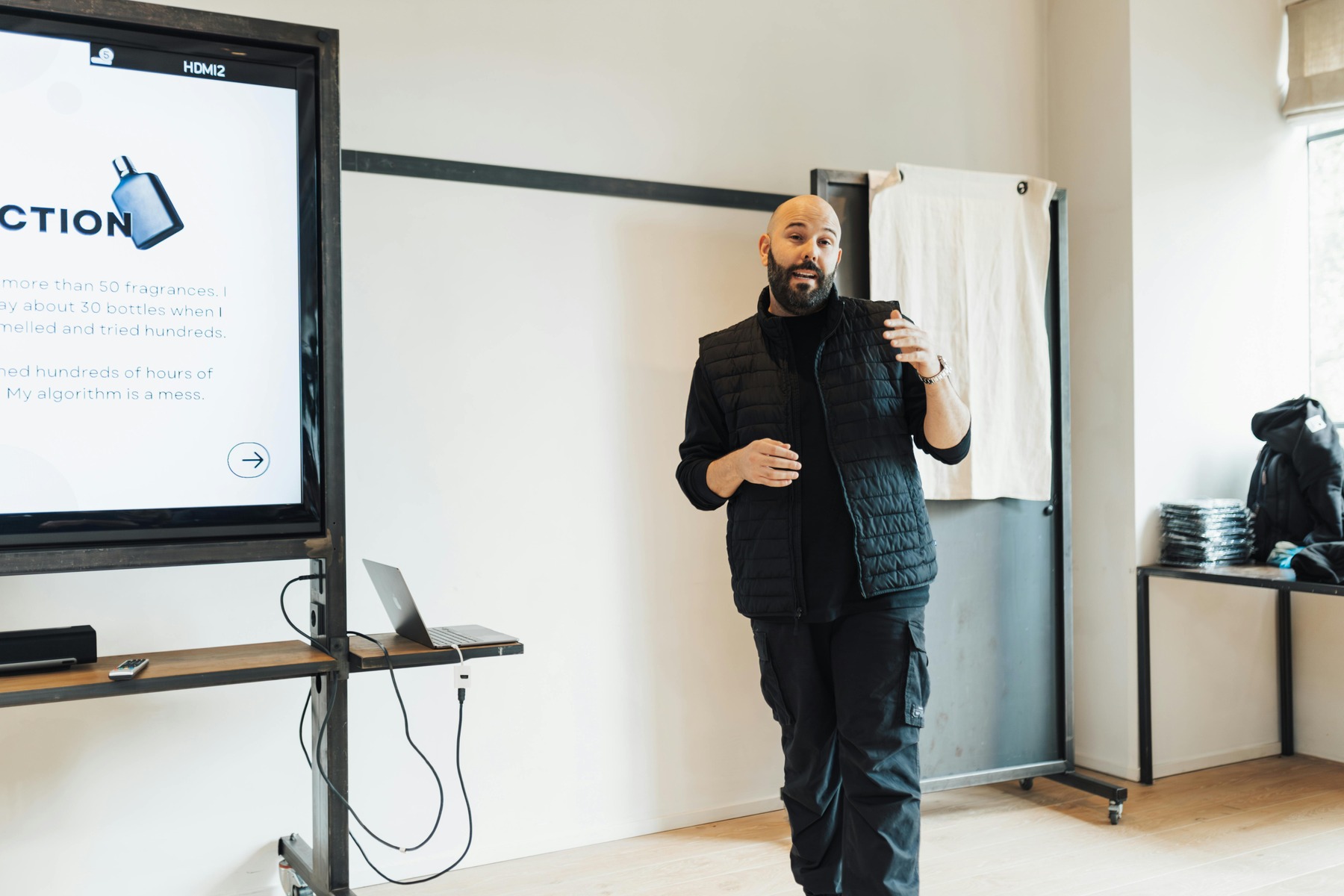Without the ability to improvise effectively, you may stumble over your words and lose your audience’s attention. We’ve created improvisation strategies that have helped corporate leaders, presenters, and actors deal with unexpected questions and situations. Here are our top must-know improvisation techniques for public speaking.
Improvisation Techniques for Public Speaking
Effective improvisation in public speaking begins with understanding the basics, including overcoming stage fright, actively listening to your audience, and developing your own speaking style. You’ll also need to gain core improv skills like engaging with the crowd. Do exercises like character switches and word association to help you craft authentic narratives in any situation.
 By using improv, you learn to think on your feet and handle unexpected situations with ease. Learn how to make your presentations and speeches more engaging using these practical tips from our public speaking specialists.
By using improv, you learn to think on your feet and handle unexpected situations with ease. Learn how to make your presentations and speeches more engaging using these practical tips from our public speaking specialists.
| Technique | Examples |
| Basics of public speaking Improvisation | Focus on positive thinking and manage stage fright
Practice active listening and read the audience’s emotions Vary your speaking style, and control voice, tone, pitch, and pacing |
| Core improv skills | Think quickly yet creatively
Use effective body language and maintain eye contact |
| Narrative storytelling | Create compelling stories that resonate with the audience
Share personal experiences |
| Engaging games and exercises | Communicate with the audience using activities |
1. Learn the Basics of Public Speaking Improvisation
Improvisation techniques can significantly enhance your public speaking abilities. These are the fundamental aspects of improving your public speaking skills with improvisation techniques.
Embracing the Power of Positivity
Approaching public speaking with a positive attitude can transform your experience. Positivity helps you connect with your audience and makes your speech more engaging. Think about what you can contribute to the audience rather than worrying about potential mistakes.
- Smile and maintain good energy.
- Focus on the message, not yourself.
- Take this as an opportunity to create something positive.
Overcoming Stage Fright With Confidence
A strong confidence can help you overcome stage fright and control shaking during public speaking. While being prepared is important, improvisation fosters the courage to handle unexpected situations. We’ve helped professionals grow their confidence by practicing these ways to beat stage fright:
- Practice deep breathing exercises.
- Picture yourself succeeding.
- Accept that making mistakes is part of the learning process.
Honing Your Active Listening Abilities
Active listening can improve relationships by 30% and enhance creativity by 20%. It involves hearing the words while also understanding the emotions and intentions behind them. This skill helps you respond appropriately and keeps the audience engaged when it’s time to do some improvisation.
- Defer judgment and ask open-ended questions.
- Nod and show empathy through facial expressions.
- Repeat or paraphrase key points to confirm understanding.
Using the Audience’s Emotions and Reactions
Paying attention to your audience’s emotions and reactions can guide your speech. When you notice people losing interest, switch topics or adjust your energy. This adaptability keeps your presentation lively and relevant.
- Observe the audience’s body language and facial expressions.
- Encourage participation with questions or comments.
- Be flexible and ready to shift your approach based on feedback.
Varying Speaking Style, Voice, Tone, Pitch, and Pacing
Variety in your speaking style makes your presentation more interesting. Change your voice, tone, pitch, and pace to emphasize important points and keep the audience engaged. This dynamic approach prevents monotony.
- Use pauses effectively to highlight key points.
- Alter your tone to maintain interest.
- Vary your pacing to match the content’s mood
2. Develop Core Improvisation Skills
Among the challenges you’ll face in public speaking is learning how to appear confident even when you’re a complete mess. This is where improv shines. These core improvisation skills can help you collect your thoughts and push through in any situation.
Thinking on Your Feet in Unexpected Situations
In public speaking, unexpected situations are common. Whether it’s a sudden question or a technical glitch, you need to think on your feet. Improv helps you develop rapid response skills.
Cultivating Creativity and Engagement
Creativity makes your speech interesting and engaging. Improvisation encourages out-of-the-box thinking and keeps your audience attentive. Try these simple methods:
- Imaginary scenario exercises to stretch your creative muscles.
- Role-playing different characters to understand various perspectives.
- Using audience suggestions to practice impromptu creativity.
Mastering Body Language and Posture
Body language communicates confidence and keeps the audience engaged. Improvisation emphasizes the importance of non-verbal cues. Focus on these aspects:
- Stand tall and open to project confidence.
- Use hand movements for emphasis.
- Match your expressions with the tone of your message.
Making Eye Contact for Authentic Connection
Eye contact creates a connection with your audience, making your message more credible and relatable. Improvisation teaches you how to use eye contact effectively.
- Move your gaze naturally across the audience.
- Look at specific people for brief moments to make your message feel personal.
- Use improv activities that focus on maintaining eye contact while speaking.
3. Incorporate Stories In Your Narrative
Telling a story while speaking in public can keep your audience engaged and convey your message effectively, even if you have to improvise some parts.
When working on random prompts or unexpected questions from the crowd, knowing how to create coherent narratives can provide structure and direction in your message delivery. This can also keep your audience engaged as you add compelling stories to your speeches.
 Techniques for Captivating Storytelling
Techniques for Captivating Storytelling
The secret to good storytelling is to use vivid details and descriptive language to paint a picture in your audience’s minds.
- Hook your listeners using the first few sentences and making them want to hear more. Engage your audience from the start with a compelling opening.
- Break your story into clear, manageable segments to help the audience follow along easily. Each segment should have a clear purpose, whether it’s setting the scene, introducing characters, or presenting a conflict.
- Incorporate dialogue to bring your characters to life and make your story more relatable. When your characters speak, your audience can connect with them on a personal level.
- Pause at the right moment to build suspense or emphasize a critical point. Adjust your speaking speed to match the story’s mood. Slow down during serious moments and speed up during exciting parts.
Authenticity and Passion in Your Stories
When you speak from the heart, your audience is more likely to trust you and feel a connection. Authentic stories reflect your values and beliefs, making your message more impactful.
Passion is equally important. Show enthusiasm about the topic and the story you’re sharing. Your energy can be contagious, encouraging your audience to be interested and engaged.
This makes your story relevant and helps listeners see themselves in your narrative. When they can relate, they’re more likely to remember and be moved by your message.
4. Incorporate Improv Games and Exercises
Using improv games can make your public speaking more lively and engaging. Each exercise encourages quick thinking and adaptability. It’s also one of the best ways to start a public address that will hook your audience.
Below are some of the improv exercises we incorporate in our public speaking lessons. Our students also do this in their own groups and audiences.
“Yes, And”
The “Yes, And” concept originated from Viola Spolin, who is widely attributed as the mother of modern improvisation. In this game, you build on whatever your partner says by starting your sentence with “Yes, and…”. This exercise teaches you to listen carefully and adapt on the fly.
As you add to what others say, you learn to keep the conversation flowing and make it more dynamic. Aside from honing your active listening skills, you’ll also learn how to collaborate with your audience and encourage yourself to accept the ideas of others.
Character Switch
In this exercise, you switch characters with your partner during a conversation. For example: You might start as a teacher and then switch to a student. This exercise helps you think from different perspectives.
This shift in roles can make your presentations more relatable and captivating. It also helps you understand your audience better by considering multiple viewpoints.
Word Association
This game involves saying the first word that comes to mind in response to another word. It’s excellent for increasing mental agility and creativity. This can be incredibly helpful when delivering a speech, allowing you to think on your feet more effectively.
Storytelling Circle
In this activity, participants take turns adding one sentence to a story. The goal is to create a cohesive and interesting narrative together. This exercise helps you develop a natural flow in your storytelling, making your speeches more compelling and easier to follow.
Gibberish Translation
One person speaks in gibberish while the other translates it into coherent speech. It’s a fun activity that teaches you to convey and interpret meaning beyond words. This game can be especially useful in making your speeches more expressive and engaging, even when words fail you.
Related Questions
How Can Improvisation Help With Public Speaking?
Improvisation can help with public speaking by enhancing spontaneity and adaptability, allowing speakers to think on their feet and respond effectively to unexpected situations. It also builds confidence and reduces anxiety, enabling you to connect more authentically with your audience.
How Can I Prepare for Improvisation?
To prepare for potential improvisation, you can engage in quick word association games or short role-playing exercises to get your creative juices flowing. Additionally, physical warm-ups like stretching or individualized vocal exercises can help relax your body and prepare you for an impactful performance.
Where Can I Learn Improvisation?
You can learn improvisation through dedicated improve classes at local theaters, comedy clubs, or community centers. For a more diverse approach, consider enrolling in personalized voice training that covers various topics related to communication, including speaking styles, vocal health, and improvisation techniques.
Conclusion
Improvisation helps you become more comfortable with making mistakes. Instead of freezing up, you learn to turn slip-ups into opportunities to connect with your audience through enterprise training. As you adopt our suggested strategies, you can deliver more dynamic, relatable, and impactful presentations while making yourself more adaptable and confident in public speaking.








